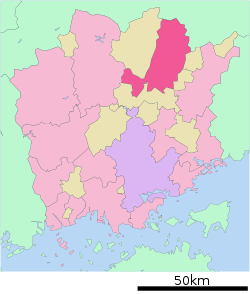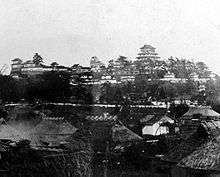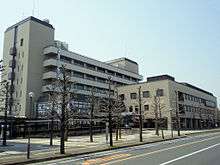Tsuyama, Okayama
| Tsuyama 津山市 | ||
|---|---|---|
| City | ||
| ||
 Location of Tsuyama in Okayama Prefecture | ||
 Tsuyama Location in Japan | ||
| Coordinates: 35°4′10″N 134°0′16″E / 35.06944°N 134.00444°ECoordinates: 35°4′10″N 134°0′16″E / 35.06944°N 134.00444°E | ||
| Country | Japan | |
| Region | Chūgoku (Sanyō) | |
| Prefecture | Okayama Prefecture | |
| Government | ||
| • Mayor | Akinori Miyaji (since March 2010) | |
| Area | ||
| • Total | 506.36 km2 (195.51 sq mi) | |
| Population (December 1, 2010) | ||
| • Total | 108,057 | |
| • Density | 213.40/km2 (552.7/sq mi) | |
| Symbols | ||
| • Tree | Camphor laurel | |
| • Flower | Satsuki azalea, Sakura | |
| Time zone | Japan Standard Time (UTC+9) | |
| City hall address |
520 Yamakita, Tsuyama-shi, Okayama-ken 708-8501 | |
| Website |
www | |
Tsuyama (津山市 Tsuyama-shi) is a city in Okayama Prefecture, Japan.
As of 2003, the city had an estimated population of 89,974 and a population density of 484.43 persons per km². The total area was 185.73 km². The area increased in 2005 as the result of a merger with adjacent towns, which also boosted the city's population to more than 100,000.
History
The city was founded on February 11, 1929.

Tsuyama is known for the 17th century Tsuyama Castle, whose grandeur was said to rival that of Himeji Castle in neighboring Hyōgo Prefecture. The castle was destroyed in 1874, and today only the stone foundations remain, save for a single turret that was reconstructed in 2005. The castle ruins remain Tsuyama's main tourist attraction along with Joto Street, a narrow street of old, traditional buildings that was once part of the pilgrimage route from Kyoto to Izumo, and Shurakuen Garden, a traditional Japanese garden constructed in 1657.
The 1938 Tsuyama massacre, in which 21-year-old Mutsuo Toi murdered 30 people in the course of one and a half hours, took place in a village near Tsuyama which became part of the city of Tsuyama in 2005. It was considered for several decades to be the world's largest massacre committed by a single criminal.
On February 28, 2005, the town of Kamo, the village of Aba (both from Tomata District), the town of Shōboku (from Katsuta District), and the town of Kume (from Kume District) were merged into Tsuyama.
Climate
Tsuyama has a humid subtropical climate (Köppen climate classification Cfa) with very warm summers and cold winters. Precipitation is significant throughout the year, but is somewhat lower in winter.
| Climate data for Tateyama, Okayama | |||||||||||||
|---|---|---|---|---|---|---|---|---|---|---|---|---|---|
| Month | Jan | Feb | Mar | Apr | May | Jun | Jul | Aug | Sep | Oct | Nov | Dec | Year |
| Average high °C (°F) | 7.2 (45) |
8.4 (47.1) |
12.4 (54.3) |
19.1 (66.4) |
23.6 (74.5) |
26.3 (79.3) |
30.1 (86.2) |
31.6 (88.9) |
27.0 (80.6) |
21.2 (70.2) |
15.3 (59.5) |
9.7 (49.5) |
19.33 (66.79) |
| Daily mean °C (°F) | 1.7 (35.1) |
2.5 (36.5) |
5.7 (42.3) |
12.0 (53.6) |
16.7 (62.1) |
20.7 (69.3) |
24.8 (76.6) |
25.6 (78.1) |
21.2 (70.2) |
14.7 (58.5) |
8.8 (47.8) |
3.7 (38.7) |
13.17 (55.73) |
| Average low °C (°F) | −2.4 (27.7) |
−2.0 (28.4) |
0.2 (32.4) |
5.7 (42.3) |
10.5 (50.9) |
16.2 (61.2) |
21.1 (70) |
21.5 (70.7) |
17.0 (62.6) |
9.8 (49.6) |
4.0 (39.2) |
−0.7 (30.7) |
8.41 (47.14) |
| Average precipitation mm (inches) | 48.4 (1.906) |
57.0 (2.244) |
95.8 (3.772) |
144.1 (5.673) |
153.1 (6.028) |
230.1 (9.059) |
258.8 (10.189) |
125.5 (4.941) |
223.8 (8.811) |
96.3 (3.791) |
64.2 (2.528) |
34.8 (1.37) |
1,531.9 (60.312) |
| Average snowfall cm (inches) | 22 (8.7) |
17 (6.7) |
7 (2.8) |
0 (0) |
0 (0) |
0 (0) |
0 (0) |
0 (0) |
0 (0) |
0 (0) |
0 (0) |
8 (3.1) |
54 (21.3) |
| Average relative humidity (%) | 77 | 75 | 72 | 71 | 73 | 78 | 82 | 79 | 80 | 79 | 81 | 80 | 77.3 |
| Mean monthly sunshine hours | 127.4 | 128.3 | 166.4 | 178.5 | 202.7 | 158.3 | 154.2 | 189.1 | 147.1 | 154.5 | 120.3 | 116.2 | 1,843 |
| Source: NOAA (1961-1990)[1] | |||||||||||||
Festivals
- Cherry Blossom Festival (early April) - This event is held in Kakuzan Park where around 5000 cherry blossom trees attract people from all over western Japan. Many picnickers arrive before dawn and set down blue tarps and then remain until dusk, grilling out and drinking sake.
- Gongo Festival (First Saturday and Sunday of August) - The Gongo, or Kappa, is a fictitious animal said to live in rivers. The festival is based around the legend that the Gongo can be seen in the Yoshii River in summer. Local people congregate on the banks of the river wearing traditional Japanese clothing and eat and drink at the many temporary stalls set up there. The festival culminates in a spectacular firework display on the Sunday evening.
- Tsuyama Autumn Festival (Mid to late October) - Many people parade through the town pulling danjiri.
- Lion Dance Festival (October 17) - The Lion Dance Festival, held at Takata Shrine, began around 710 A.D. to thank the gods for a good harvest. A male and female lion, each controlled by twelve dancers, perform a soul-stirring dance imitating a struggle. The lions keep time with a flute and drum. The dance is believed to drive away the devil and impurity.
- Old Izumo Street Festival (Beginnining of November on Sunday) - A festival on Joto Street during which they wear traditional clothes and open a theater, tea houses, and various stalls.
Attractions
- Kakuzan Park
- Tsuyama Castle
- Shūraku-en Garden
- Joto Street
- Nakayama Shrine
- Tsuyama Archives of Western Learning
- Genpo Mitsukuri's Former Residence
- Tsuyama Museum of Science Education
- Tsuyuma Historical Museum
- Tsuyama Railroad Educational Museum (opening spring 2016)
- Yayoi Village Replica
- Yokono Falls
- Sakura Shrine
- Tsuyama Wonder Museum

Education
Transport
Tsuyama's main railway station is Tsuyama Station. The station is served by the Tsuyama Line (to Okayama), the Kishin Line (to Himeji and Niimi), and the Inbi Line (to Tottori). All services are operated by JR West. Tsuyama is one of the major cities along the Chūgoku Expressway. As with many Japanese cities, cycling is a very common form of transport, particularly among school students.
Air
The nearest airport is Okayama Airport.
Rail
- West Japan Railway Company
- Kishin Line
- Mimasaka-Ōsaki Station - Higashi-Tsuyama Station - Tsuyama Station - Innoshō Station - Mimasaka-Sendai Station - Tsuboi Station
- Inbi Line
- Mimasaka-Kawai Station - Chiwa Station - Mimasaka-Kamo Station - Miura Station - Mimasaka-Takio Station - Takano Station - Higashi-Tsuyama Station
- Tsuyama Line
- Sarayama Station - Tsuyamaguchi Station - Tsuyama Station
- Kishin Line
Road
- Expressways:
- Chūgoku Expressway
- Tsuyama Interchange - Ninomiya Parking Area - Innoshō Interchange
- Chūgoku Expressway
- National highways:
- Main prefectural roads:
- Okayama Prefectural Route 6 (Tsuyama-Chizu-Hattō)
- Okayama Prefectural Route 26 (Tsuyama-Yanahara)
- Okayama Prefectural Route 67 (Shōō-Shōboku)
- Okayama Prefectural Route 68 (Tsuyama-Kamo)
- Okayama Prefectural Route 70 (Kume-Takebe)
- Okayama Prefectural Route 75 (Kamo-Okutsu)
- Roadside Station:
- Kume no Sato
Sister cities
 Santa Fe, New Mexico, United States
Santa Fe, New Mexico, United States
Notable people from Tsuyama
- Joe Odagiri, actor
- Koshi Inaba, vocalist of B'z
- Shun Yashiro, actor
- Shinji Takahashi, baseball player
- Natsumi Kawahara, manga artist
- Ayane Sakurano, actress
- Hiranuma Kiichirō, pre World War II right-wing politician
References
- ↑ "Tsuyama Climate Normals 1961-1990". National Oceanic and Atmospheric Administration. Retrieved January 6, 2013.
External links
| Wikimedia Commons has media related to Tsuyama, Okayama. |
-
 Tsuyama travel guide from Wikivoyage
Tsuyama travel guide from Wikivoyage - Tsuyama City official website (Japanese), and some information in English
- Tsuyama tourism information (English), from the Japan National Tourism Organization
- Tsuyama High School with some information in English
- Tsuyama National College of Technology with some information in English


